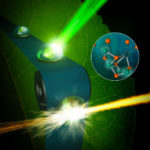An international team of scientists is getting closer to discovering how plants split water during photosynthesis and produce nearly all of the oxygen in our atmosphere. Thanks to unprecedented, atomic-scale images of a protein complex found in plants, algae, and cyanobacteria captured by ultrafast X-ray lasers, researchers conducted atomic-level experiments to help delineate the mechanism of this system that also yields the protons and electrons used to reduce carbon dioxide to carbohydrates later in the photosynthesis cycle. The effort to uncover the secrets of this protein complex, photosystem II, was led by Vittal Yachandra and Junko Yano in the Molecular Biophysics & Integrated Bioimaging (MBIB) Division and the team’s findings were published this week in Nature.
Seeing the Big Picture in Photosynthetic Light Harvesting
Graham Fleming, chemist senior faculty scientist in Molecular Biophysics & Integrated Bioimaging, led the creation of the first computational model that simulates the light-harvesting activity of the thousands of antenna proteins that would be interacting in the chloroplast of an actual leaf. The results from this model point the way to improving the yields of food and fuel crops, and developing artificial photosynthesis technologies. Read more at Berkeley Lab News Center.
Was this page useful?
Send





